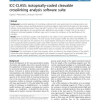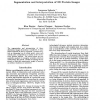101
click to vote
BMCBI
2010
15 years 1 months ago
2010
Background: The protein structures of the disease-associated proteins are important for proceeding with the structure-based drug design to against a particular disease. Up until n...
72
Voted
BMCBI
2010
15 years 1 months ago
2010
Background: Successful application of crosslinking combined with mass spectrometry for studying proteins and protein complexes requires specifically-designed crosslinking reagents...
BIOINFORMATICS
2010
15 years 1 months ago
2010
Motivation: To test whether protein folding constraints and secondary structure sequence preferences significantly reduce the space of amino acid words in proteins, we compared th...
126
Voted
ALMOB
2007
15 years 1 months ago
2007
Understanding the protein folding mechanism remains a grand challenge in structural biology. In the past several years, computational theories in molecular dynamics have been empl...
ALGORITHMICA
2007
15 years 1 months ago
2007
This paper proposes the Protein Ensemble Method (PEM) to model equilibrium fluctuations in proteins where fragments of the protein polypeptide chain can move independently of one ...
106
click to vote
ALMOB
2008
15 years 1 months ago
2008
Background: Protein structure alignments are usually based on very different techniques to sequence alignments. We propose a method which treats sequence, structure and even combi...
127
click to vote
BIBM
2008
IEEE
15 years 1 months ago
2008
IEEE
This paper addresses the protein classification problem, and explores how its accuracy can be improved by using information from time-course gene expression data. The methods are ...
87
Voted
ISMB
1994
15 years 2 months ago
1994
The segmentation and interpretation of threedimensionalimagesof proteins is considered. Atopological approachis used to represent a protein structure as a spanningtree of critical...
ISMB
1997
15 years 2 months ago
1997
Protein chimerism is a phenomenon involving the combination of multiple ancestral sequences into a single, multi-domain protein through evolution. We propose a novel method for de...



